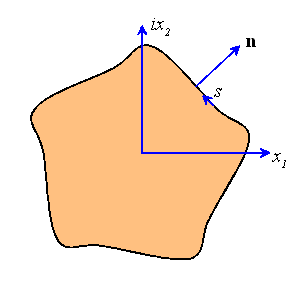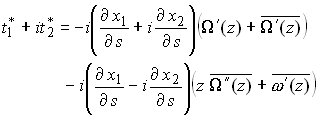 EN224: Linear
Elasticity
EN224: Linear
Elasticity 
Division of Engineering
7.2 Boundary Conditions for Plane Complex Potentials
When we worked out complex variable representations for anti-plane shear problems, we found that the boundary conditions on the complex potentials could be expressed in a very convenient and simple form. For displacement boundary value problems, the real part of the complex potential had to take on prescribed values on the boundary , while for traction boundary value problems, the complex potentials were related to the resultant forces acting on the boundaries of the solid. We find very similar results for plane elastostatic solutions too. We proceed to work out the details.

Displacement Boundary Value Problems
Let ![]() be a plane elastostatic state, satisfying boundary conditions
be a plane elastostatic state, satisfying boundary conditions
where![]() is a prescribed complex function.
is a prescribed complex function.
Then, the complex potentials![]() defined in the preceding section
must satisfy
defined in the preceding section
must satisfy
Proof: follows from the definition of the complex potentials.
Traction Boundary Value Problems
It takes a bit more work to set up boundary conditions for traction
boundary value problems. As before, let ![]() be a plane elastostatic
state, satisfying
be a plane elastostatic
state, satisfying
Define
The complex potentials ![]() defined in Section 7.1 must satisfy
defined in Section 7.1 must satisfy

Where s denotes arc length around the boundary, with positive direction defined so that the solid always lies on the left as you travel in the direction of increasing s, as shown in the figure.
Equivalently

Proof:
Write the boundary conditions as
Recall that

Therefore
Now, recall the expressions for stress fields in terms of complex potentials

so that

The boundary conditions may therefore be expressed as

Now, note that

and furthermore

so that

whence

Observe that the boundary conditions for both displacement and traction boundary value problems may be expressed in unified form:
Where

The arbitrary choice of s0 in the integral reflects the fact that displacement fields for traction boundary value problems are not unique; one can only find D to within a rigid body motion.